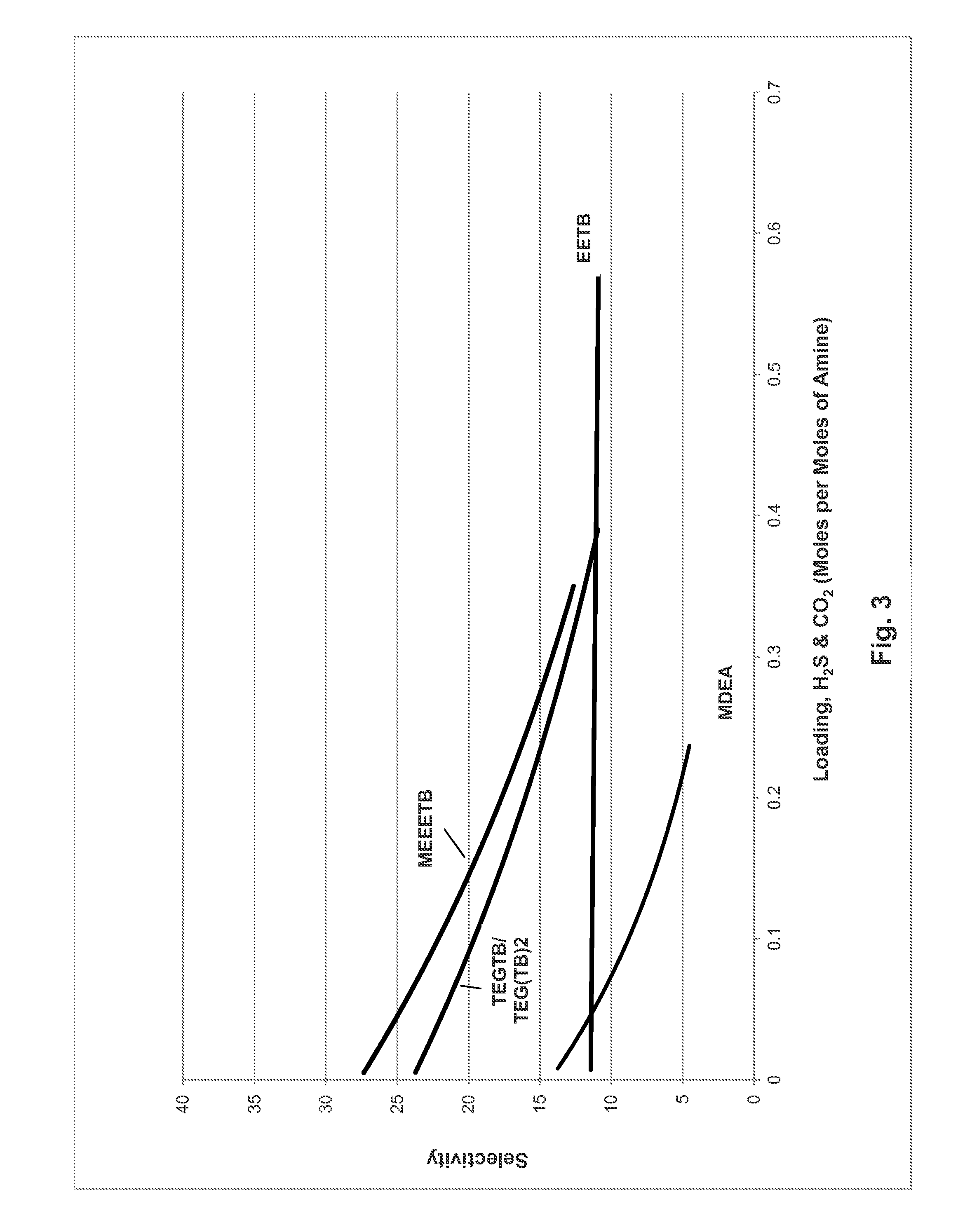Amine treating process for acid gas separation using blends of amines and alkyloxyamines
- Summary
- Abstract
- Description
- Claims
- Application Information
AI Technical Summary
Benefits of technology
Problems solved by technology
Method used
Image
Examples
example 1
[0067]Mixtures of two etheramines, t-butylaminoethoxyethanol (EETB) and methoxy-triethylene glycol-t-butylamine (MEEETB, t-butylamino-ethoxyethoxyethyl methyl ether) in varying ratios were tested for their absorption characteristics by bubbling a gas mixture containing 10% v / v CO2, 1% H2S, balance N2, through a stirred 2.17 molar aqueous amine mixture at 40° C. (absorbent and gas), 138 kPag (20 psig) at a gas flow rate of 600 mL / min. The five gas ratios tested were (EETB / MEEETB): 100 / 0; 95:5; 90 / 10; 80 / 20 and 50:50.
[0068]The gas was introduced into the solvent solution down a dip tube with the outlet submerged just below (8 mm) the surface of the solvent. These parameters were found to provide stable and repeatable data for both MDEA and other solutions. The test gas was water saturated before entering the test cell. A variable speed paddle mixer circulated solvent past the dip tube at a controlled rate. The cell was run at atmospheric pressure. Gas venting from the cell was passed ...
example 2
[0070]Further studies with etheramines and blends of etheramines carried out in the same manner showed that the blends possessed potential advantages in H2S selectivity and loading in comparison with single etheramines, as shown by Table 1 below:
TABLE 1LoadingCapacitySelectivity-CompoundMol. Wt.Selectivity(%)(%)ReabsorptionEETB161.2414.517.461.015.3Bis-SE216.3616.7628.280.025.2MEEETB219.3264.424.298.469.7TEG(TB)2260.4223.319.465.139.2TEGTB205.26 / 128.245.482.6131.2(32.2%) / 260.42TEG(TB)2(67.4%)Bis-SE = Bis-(t-butylamino)-diethylene glycolTEGTB = Triethylene glycol-t-butylamineTEG(TB)2 = Bis-(t-butylamino)-triethylene glycolLoading = Moles of H2S / Moles of absorbentCapacity = Moles of H2S absorbed by solution / Moles of H2S after desorption from solution.
[0071]Thus, even though the mixture of TEGTB and TEG(TB)2 has a molecular weight disadvantage (weighted average mol. wt of 241.61) compared to MEEETB (219.32) resulting in fewer moles of absorbent per unit weight purchased, the increased ...
example 3
[0072]The evaluation was continued by the same method using MDEA, EETB, MEEETB and a mixture of TEGTB and TEG(TB)2 (57.8% / 35% with unreacted TEG as balance) to show the relationship of H2S selectivity with over a range of loadings. The results are shown in FIG. 3. MDEA is approximately as selective as EETB but only at very low loadings after which the selectivity becomes sharply worse at higher rates. EETB has the virtue of having a linear selectivity at all loadings. MEEETB and the TEG blend are significantly more selective than EETB at low to moderate loadings with MEETB having a marginal advantage but given the doubling in loading afforded by the bis-(amino) derivative in the mixture (see Example 2), the blend has a clear advantage in selectivity over the other material.
PUM
| Property | Measurement | Unit |
|---|---|---|
| Molar ratio | aaaaa | aaaaa |
| Selectivity | aaaaa | aaaaa |
| Water absorption | aaaaa | aaaaa |
Abstract
Description
Claims
Application Information
 Login to View More
Login to View More - R&D Engineer
- R&D Manager
- IP Professional
- Industry Leading Data Capabilities
- Powerful AI technology
- Patent DNA Extraction
Browse by: Latest US Patents, China's latest patents, Technical Efficacy Thesaurus, Application Domain, Technology Topic, Popular Technical Reports.
© 2024 PatSnap. All rights reserved.Legal|Privacy policy|Modern Slavery Act Transparency Statement|Sitemap|About US| Contact US: help@patsnap.com










